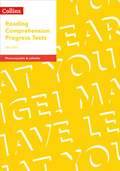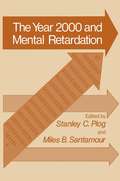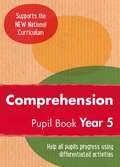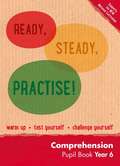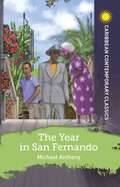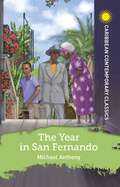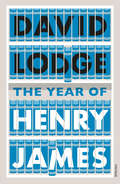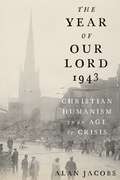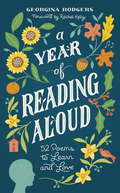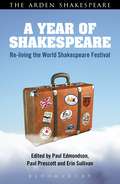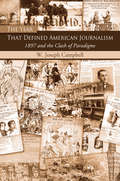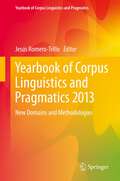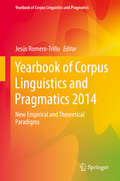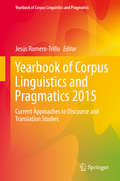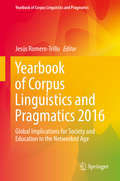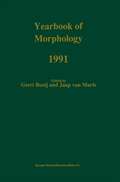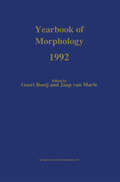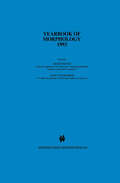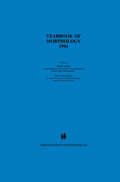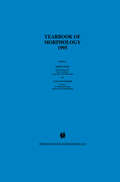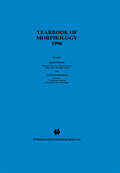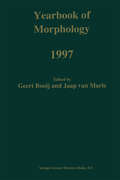- Table View
- List View
Year 2/P3 Reading Comprehension Progress Tests: Collins Tests & Assessment (Collins Tests And Assessment Ser.)
by Shelley WelshCheck pupils are on track and making expected progress with six reading comprehension tests for Year 2/P3. Carefully selected extracts provide a range of vocabulary, styles and content to build reading skills towards KS2 SATs. Photocopiable and editable, these informal tests help identify gaps in learning and next steps. Assess pupils’ comprehension skills in Year 2 with questions use SATs style language to help build familiarity and confidence for end of KS1 tests. Measure progress every half term with short, illustrated, cross curricular fiction, non-fiction and poetry comprehension tests. There are two extracts per test. Check pupils are on track for the expected standard with guidance and SATs style mark schemes. Save time with high quality tests written by primary literacy experts and a range of unseen age-appropriate extracts. Easy to use with national curriculum objectives and content domain references set out in a yearly overview. Available for Years 1–6/P2–P7, you can provide a consistent and systematic way of assessing reading comprehension in your school.
Year 2000 and Mental Retardation (Current Topics in Mental Health)
by Stanley C. PlogThe future is exciting-frightening-and demanding! As social and eco nomic change accelerates at an ever-increasing rate, we look with awe and wonder at the way in which unanticipated events impact on our lives and change the way we live. We are also frightened about how well we will adapt to the demands of a world that may be structured quite differently from the familiar environment of today. If we are to handle our own futures with some degree of skill and adap tiveness, we need to begin planning today for the dawn of the next century. Otherwise, we may find that events have overrun our capacity to cope. Those of us in the social and helping sectors of the economy have a responsibility for the future welfare of persons who are less able to look out for their own needs or to protect themselves from the vagaries of economic fluctuations or major dislocations in the social fabric of the land. The President's Committee on Mental Retardation is proud of its deci sion to look at the year 2000 and its impact on the mentally retarded. Our goals were straightforward-to understand how unfolding events can affect the lives of the mentally retarded, for good or ill, a generation from now.
Year 5 Comprehension Pupil Book: (PDF)
by Keen Kite Books StaffPupils can quickly get to grips with KS2 comprehension using questions that become progressively more challenging. Fully in line with the new National Curriculum.
Year 6 Comprehension Pupil Book (PDF)
by Keen Kite BooksPupils can quickly get to grips with KS2 comprehension using questions that become progressively more challenging. Fully in line with the new National Curriculum.
The Year in San Fernando (Caribbean Modern Classics)
by Michael AnthonyThere have been many great and enduring works of literature by Caribbean authors over the last century. The Caribbean Contemporary Classics collection celebrates these deep and vibrant stories, overflowing with life and acute observations about society.This luminous book recounted through the eyes of the 12-year-old Francis, describes the year he spends, far away from home, in San Fernando. As his initial confusion gives way to increasing confidence and maturity, the open consciousness of the boy allows different times, events and places to co-exist.Over the course of one year, through Francis' eyes, we see the cycle of natural change and progression; the daily round of the market, showing the fruits of different seasons, the passage of dry season to rainy and back again to dry, the cane fires as the crop comes to an end, all symbolising the progression of the boy's year. And weaving in and amongst these mundane but intense experiences Francis feels his way to some understanding of adulthood.
The Year in San Fernando (Caribbean Modern Classics)
by Michael AnthonyThere have been many great and enduring works of literature by Caribbean authors over the last century. The Caribbean Contemporary Classics collection celebrates these deep and vibrant stories, overflowing with life and acute observations about society.This luminous book recounted through the eyes of the 12-year-old Francis, describes the year he spends, far away from home, in San Fernando. As his initial confusion gives way to increasing confidence and maturity, the open consciousness of the boy allows different times, events and places to co-exist.Over the course of one year, through Francis' eyes, we see the cycle of natural change and progression; the daily round of the market, showing the fruits of different seasons, the passage of dry season to rainy and back again to dry, the cane fires as the crop comes to an end, all symbolising the progression of the boy's year. And weaving in and amongst these mundane but intense experiences Francis feels his way to some understanding of adulthood.
The Year of Henry James: The story of a novel: With other essays on the genesis, composition and reception of literary fiction
by David LodgeIn 2004, Henry James featured as a character in no less than three novels - David Lodge's Author, Author was one of them. With insightful and amusing candour, here he traces the history of his book from conception to publication, pondering the mystery - and indeed the anguish - of so many novels about James appearing at the same time. Lodge's reflections on his own creative practice are accompanied by studies of the genesis, composition and reception of key works by James himself, as well as other novelists from George Eliot to Vladimir Nabokov, and J.M. Coetzee to Graham Greene.
The Year of Our Lord 1943: Christian Humanism in an Age of Crisis
by Alan JacobsBy early 1943, it had become increasingly clear that the Allies would win the Second World War. Around the same time, it also became increasingly clear to many Christian intellectuals on both sides of the Atlantic that the soon-to-be-victorious nations were not culturally or morally prepared for their success. A war won by technological superiority merely laid the groundwork for a post-war society governed by technocrats. These Christian intellectuals-Jacques Maritain, T. S. Eliot, C. S. Lewis, W. H. Auden, and Simone Weil, among others-sought both to articulate a sober and reflective critique of their own culture and to outline a plan for the moral and spiritual regeneration of their countries in the post-war world. In this book, Alan Jacobs explores the poems, novels, essays, reviews, and lectures of these five central figures, in which they presented, with great imaginative energy and force, pictures of the very different paths now set before the Western democracies. Working mostly separately and in ignorance of one another's ideas, the five developed a strikingly consistent argument that the only means by which democratic societies could be prepared for their world-wide economic and political dominance was through a renewal of education that was grounded in a Christian understanding of the power and limitations of human beings. The Year of Our Lord 1943 is the first book to weave together the ideas of these five intellectuals and shows why, in a time of unprecedented total war, they all thought it vital to restore Christianity to a leading role in the renewal of the Western democracies.
The Year of Our Lord 1943: Christian Humanism in an Age of Crisis
by Alan JacobsBy early 1943, it had become increasingly clear that the Allies would win the Second World War. Around the same time, it also became increasingly clear to many Christian intellectuals on both sides of the Atlantic that the soon-to-be-victorious nations were not culturally or morally prepared for their success. A war won by technological superiority merely laid the groundwork for a post-war society governed by technocrats. These Christian intellectuals-Jacques Maritain, T. S. Eliot, C. S. Lewis, W. H. Auden, and Simone Weil, among others-sought both to articulate a sober and reflective critique of their own culture and to outline a plan for the moral and spiritual regeneration of their countries in the post-war world. In this book, Alan Jacobs explores the poems, novels, essays, reviews, and lectures of these five central figures, in which they presented, with great imaginative energy and force, pictures of the very different paths now set before the Western democracies. Working mostly separately and in ignorance of one another's ideas, the five developed a strikingly consistent argument that the only means by which democratic societies could be prepared for their world-wide economic and political dominance was through a renewal of education that was grounded in a Christian understanding of the power and limitations of human beings. The Year of Our Lord 1943 is the first book to weave together the ideas of these five intellectuals and shows why, in a time of unprecedented total war, they all thought it vital to restore Christianity to a leading role in the renewal of the Western democracies.
A Year of Reading Aloud: 52 poems to learn and love
by Georgina Rodgers'In a world in which we tend to look to what's new, to cutting-edge science and to medical breakthroughs for hope in better health, there's something marvellous in the realisation that one of the most beautiful and longest-lasting cures has been here all along - on the internet, on our bookshelves, under our noses. Words - down the centuries, over the ether, across the miles - have power to steady us, to make us feel better.' the ObserverThe ancient tradition of learning and reciting poetry is renowned for its wellbeing benefits - from strengthening the mind and boosting creativity to improving memory. The practice is as valuable as ever in our busy modern day lives, allowing us to focus on the rhythm of the present moment, slow down and switch off.A Year of Reading Aloud celebrates the power of spoken word with a poem to learn and love for each week of the year. Drawing both on familiar favourites and new voices, from Sylvia Plath and Maya Angelou to Instapoets Nikita Gill and Yrsa Daley-Ward - this is a book that will capture your imagination through verse and help you fall back in love with this beautiful art form. Includes a foreword by Rachel Kelly, bestselling author of 52 Small Steps to Happiness and Black Rainbow.
A Year of Shakespeare: Re-living the World Shakespeare Festival
by Paul Edmondson Paul Prescott Erin SullivanA Year of Shakespeare gives a uniquely expert and exciting overview of the largest Shakespeare celebration the world has ever known: the World Shakespeare Festival 2012. This is the only book to describe and analyse each of the Festival's 73 productions in well-informed,lively reviews by eminent and up-and-coming scholars and critics from the UK and around the world. A rich resource of critical interest to all students, scholars and lovers of Shakespeare, the book also captures the excitement of this extraordinary event.A Year of Shakespeare provides:• a ground-breaking collection of Shakespearean reviews, covering all of the Festival's productions;• a dynamic visual record through a wide range of production photographs;• incisive analysis of the Festival's significance in the wider context of the Cultural Olympiad 2012.All the world really is a stage, and it's time for curtain-up…
A Year of Shakespeare: Re-living the World Shakespeare Festival
by Paul Edmondson Paul Prescott Erin SullivanA Year of Shakespeare gives a uniquely expert and exciting overview of the largest Shakespeare celebration the world has ever known: the World Shakespeare Festival 2012. This is the only book to describe and analyse each of the Festival's 73 productions in well-informed,lively reviews by eminent and up-and-coming scholars and critics from the UK and around the world. A rich resource of critical interest to all students, scholars and lovers of Shakespeare, the book also captures the excitement of this extraordinary event.A Year of Shakespeare provides:• a ground-breaking collection of Shakespearean reviews, covering all of the Festival's productions;• a dynamic visual record through a wide range of production photographs;• incisive analysis of the Festival's significance in the wider context of the Cultural Olympiad 2012.All the world really is a stage, and it's time for curtain-up…
The Year That Defined American Journalism: 1897 and the Clash of Paradigms
by W. Joseph CampbellThe Year that Defined American Journalism explores the succession of remarkable and decisive moments in American journalism during 1897 – a year of significant transition that helped redefine the profession and shape its modern contours. This defining year featured a momentous clash of paradigms pitting the activism of William Randolph Hearst's participatory 'journalism of action' against the detached, fact-based antithesis of activist journalism, as represented by Adolph Ochs of the New York Times, and an eccentric experiment in literary journalism pursued by Lincoln Steffens at the New York Commercial-Advertiser. Resolution of the three-sided clash of paradigms would take years and result ultimately in the ascendancy of the Times' counter-activist model, which remains the defining standard for mainstream American journalism. The Year That Defined American Journalism introduces the year-study methodology to mass communications research and enriches our understanding of a pivotal moment in media history.
The Year That Defined American Journalism: 1897 and the Clash of Paradigms
by W. Joseph CampbellThe Year that Defined American Journalism explores the succession of remarkable and decisive moments in American journalism during 1897 – a year of significant transition that helped redefine the profession and shape its modern contours. This defining year featured a momentous clash of paradigms pitting the activism of William Randolph Hearst's participatory 'journalism of action' against the detached, fact-based antithesis of activist journalism, as represented by Adolph Ochs of the New York Times, and an eccentric experiment in literary journalism pursued by Lincoln Steffens at the New York Commercial-Advertiser. Resolution of the three-sided clash of paradigms would take years and result ultimately in the ascendancy of the Times' counter-activist model, which remains the defining standard for mainstream American journalism. The Year That Defined American Journalism introduces the year-study methodology to mass communications research and enriches our understanding of a pivotal moment in media history.
Yearbook of Corpus Linguistics and Pragmatics 2013: New Domains and Methodologies (Yearbook of Corpus Linguistics and Pragmatics #1)
by Jesús Romero-TrilloThe Yearbook of Corpus Linguistics and Pragmatics 2013 discusses current methodological debates on the synergy of Corpus Linguistics and Pragmatics research. The volume presents insightful pragmatic analyses of corpora in new technological domains and devotes some chapters to the pragmatic description of spoken corpora from various theoretical traditions. The Yearbook of Corpus Linguistics and Pragmatics series will give readers insight into how pragmatics can be used to explain real corpus data, and, in addition, how corpora can explain pragmatic intuitions, and from there, develop and refine theory. Corpus Linguistics can offer a meticulous methodology based on mathematics and statistics, while Pragmatics is characterized by its efforts to interpret intended meaning in real language. This yearbook offers a platform to scholars who combine both research methodologies to present rigorous and interdisciplinary findings about language in real use.
Yearbook of Corpus Linguistics and Pragmatics 2014: New Empirical and Theoretical Paradigms (Yearbook of Corpus Linguistics and Pragmatics #2)
by Jesús Romero-TrilloThe Yearbook of Corpus Linguistics and Pragmatics addresses the interface between the two disciplines and offers a platform to scholars who combine both methodologies to present rigorous and interdisciplinary findings about language in real use. Corpus linguistics and Pragmatics have traditionally represented two paths of scientific thought, parallel but often mutually exclusive and excluding. Corpus Linguistics can offer a meticulous methodology based on mathematics and statistics, while Pragmatics is characterized by its effort in the interpretation of intended meaning in real language. This series will give readers insight into how pragmatics can be used to explain real corpus data and also, how corpora can illustrate pragmatic intuitions.The present volume, Yearbook of Corpus Linguistics and Pragmatics 2014: New Empirical and Theoretical Paradigms in Corpus Pragmatics, proposes innovative research models in the liaison between pragmatics and corpus linguistics to explain language in current cultural and social contexts.
Yearbook of Corpus Linguistics and Pragmatics 2015: Current Approaches to Discourse and Translation Studies (Yearbook of Corpus Linguistics and Pragmatics #3)
by Jesús Romero-TrilloThe present volume, Current Approaches to Discourse and Translation Studies, presents innovative theoretical models and applications of the two disciplines in intercultural contexts.The Yearbook of Corpus Linguistics and Pragmatics offers a platform to scholars who carry out rigorous and interdisciplinary research on language in real use. Corpus linguistics and Pragmatics have traditionally represented two paths of scientific research, parallel but often mutually exclusive and excluding. Corpus Linguistics can offer a meticulous methodology based on mathematics and statistics while Pragmatics strives to interpret intended meaning in real language. This series will give readers insight into how pragmatics can be used to explain real corpus data, and how corpora can illustrate pragmatic intuitions.
Yearbook of Corpus Linguistics and Pragmatics 2016: Global Implications for Society and Education in the Networked Age (Yearbook of Corpus Linguistics and Pragmatics)
by Jesús Romero-TrilloThe present volume of the Yearbook of Corpus Linguistics and Pragmatics series, presents cutting-edge corpus pragmatics research on language use in new social and educational environments.The Yearbook of Corpus Linguistics and Pragmatics offers a platform to scholars who carry out rigorous and interdisciplinary research on language in real use. Corpus Linguistics and Pragmatics have traditionally represented two paths of scientific research, parallel but often mutually exclusive and excluding. Corpus Linguistics can offer a precise methodology based on mathematics and statistics while Pragmatics strives to interpret intended meaning in real language. This series will give readers insight into how pragmatics can be used to explain real corpus data, and how corpora can illustrate pragmatic intuitions.
Yearbook of Morphology 1991 (Yearbook of Morphology)
by G. E. Booij Jaap Van MarleMARK ARONOFF The articles included in this section represent recent research on morpholog ical classes which has been independently performed by a number of investi gators. This work was presented at a symposium that was organized as part of the 1990-1991 annual meeting of the Linguistic Society of America in Chicago in January 1991. Our aim in presenting this work is twofold: on the one hand, we would like to encourage others interested in morphology to pursue the types of research that we present. This is especially important in the study of morphological classes, which, while they are widespread among the languages of the world, are also highly diverse and often quite complex. On the other hand, we hope to convince researchers in adjacent areas to provide a place for autonomous morphology in their general picture of the workings of language and to pay closer attention to the intricacies of the interactionbetweenmorphologyand theseareas.
Yearbook of Morphology 1992 (Yearbook of Morphology)
by Geert Booij Jaap Van MarleA revival of interest in morphology has taken place during recent years and the subject is seen now as a relatively autonomous subdiscipline of linguistics. As one of the important areas of theoretical research in formal linguistics, morphology has attracted linguists to investigate its relations to syntax, semantics, phonology, psycholinguistics and language change. The aim of the Yearbook of Morphology, therefore, is to support and enforce the upswing of morphological research and to give an overview of the current issues and debates at the heart of this revival.
Yearbook of Morphology 1993 (Yearbook of Morphology)
by Geert Booij Jaap Van MarleRecent years have seen a revival of interest in morphology. The Yearbook of Morphology series supports and enforces this upswing of morphological research and gives an overview of the current issues and debates at the heart of this revival. The Yearbook of Morphology 1993 focuses on prosodic morphology, i.e. the interaction between morphological and prosodic structure, on the semantics of word formation, and on a number of related issues in the realm of inflection: the structure of paradigms, the relation between inflection and word formation, and patterns of language change with respect to inflection. There is also discussion of the relevance of the notion `level ordering' for morphological generalizations. All theoretical and historical linguists, morphologists, and phonologists will want to read this volume.
Yearbook of Morphology 1994 (Yearbook of Morphology)
by Geert Booij Jaap Van MarleRecent years have seen a revival of interest in morphology. The Yearbook of Morphology series supports and enforces this upswing of morphological research and gives an overview of the current issues and debates at the heart of this revival. The Yearbook of Morphology 1994 focuses on prosodic morphology, i.e. the interaction between morphological and prosodic structure, on the semantics of word formation, and on a number of related issues in the realm of inflection: the structure of paradigms, the relation between inflection and word formation, and patterns of language change with respect to inflection. There is also discussion of the relevance of the notion `level ordering' for morphological generalizations. All theoretical and historical linguists, morphologists, and phonologists will want to read this book.
Yearbook of Morphology 1995 (Yearbook of Morphology)
by JaapMarle GeertBooijA revival of interest in morphology has occurred during recent years. The aim of the Yearbook of Morphology series is to support and enforce this upswing of morphological research and to give an overview of the current issues and debates at the heart of this revival. The Yearbook of Morphology 1995 focuses on an important issue in the current morphological debate: the relation between inflection and word formation. What are the criteria for their demarcation, in which ways do they interact and how is this distinction acquired by children? The papers presented here concur in rejecting the `split morphology hypothesis' that claims that inflection and word formation belong to different components of the grammar. This volume also deals with the marked phenomenon of subtractive morphology and its theoretical implications. Theoretical and historical linguists, morphologists, phonologists and psycholinguists interested in linguistic issues will find this book of interest.
Yearbook of Morphology 1996 (Yearbook of Morphology)
by JaapMarle GeertBooijA revival of interest in morphology has occurred during recent years. Since 1988, the Yearbook of Morphology book series has proven to be an eminent platform for the growth of morphological research, containing articles on topics that are central in the current theoretical debates. The Yearbook of Morphology 1996 focuses on the relationship between morphology and psycholinguistics. Basic questions such as the following are discussed. To what extent does the morphological structure of a word play a role in its perception and production? Are regular complex words created anew each time they are used, or are they stored in the lexicon? The relevant evidence comes from a variety of European languages. Another important theme in this yearbook is the degree of autonomy of morphology: in which respect does it differ from other modules of the grammar? The present yearbook also contains articles on periphrasis, the nature of inflectional morphology and syncretism in derivational morphology. Audience: Theoretical and historical linguists, morphologists, phonologists and psycholinguists will find this book of interest.
Yearbook of Morphology 1997 (Yearbook of Morphology)
by G. E. Booij Jaap Van MarleInterest in morphology has revived in recent years and the Yearbook of Morphology has provided great support for this revival, with its articles on topics that are central to the current theoretical debates. The Yearbook of Morphology 1997 focuses on the relationship between morphology and other modules of the grammar, especially phonology, syntax and semantics. Among the basic questions discussed are: how does morphology differ from other modules of the grammar, syntax in particular? What are the possible forms of interaction between the modules? How does semantics constrain formal variation in morphology? The evidence adduced is derived from a variety of languages. Audience: Theoretical, descriptive and historical linguists, morphologists, phonologists, and psycholinguists.
